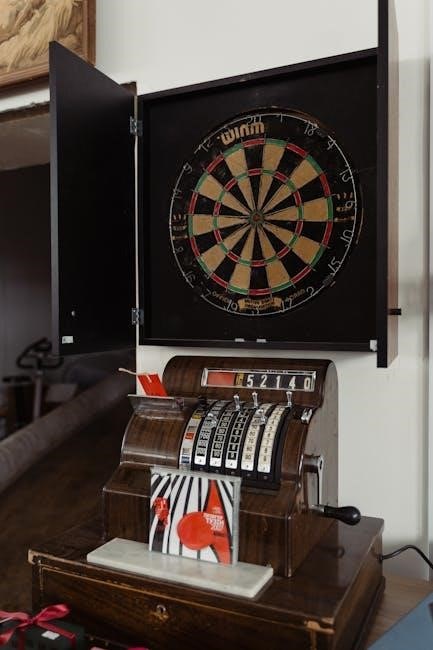This manual guides users through the Hayward Salt System, detailing its operation, maintenance, and troubleshooting. It ensures efficient saltwater chlorination for pool sanitation and optimal performance.
Overview of the Hayward Salt System
The Hayward Salt System is a advanced chlorine generation solution designed for pool sanitation. It converts salt into free chlorine, eliminating bacteria and algae while reducing harsh chemical smells. The system includes a Turbo Cell, which is the core component responsible for electrolysis. Salt levels are maintained between 2,700-3,400 ppm for optimal performance. Regular maintenance, such as cleaning the Turbo Cell and monitoring salt levels, ensures longevity. The system is compatible with various pool sizes and provides a more natural swimming experience. It integrates seamlessly with Hayward controllers for enhanced functionality and automation.
Importance of the Manual for System Operation
This manual is essential for proper installation, operation, and maintenance of the Hayward Salt System. It provides detailed instructions to ensure optimal performance and prevent damage. By following the guidelines, users can maintain the correct salt levels, clean the Turbo Cell, and troubleshoot common issues. The manual also outlines safety precautions and warranty information, ensuring safe and efficient use of the system. Adhering to the instructions helps extend the lifespan of the components and maintains water quality for a safe and enjoyable swimming experience.
Key Features of the Hayward Salt System
The Hayward Salt System features advanced chlorine generation through the Turbo Cell, ensuring clean and sanitized pool water. It includes a user-friendly control panel with LED indicators for monitoring salt levels and system status. The system is designed for energy efficiency and optimal performance, with customizable settings to suit different pool sizes. Key components include durable connectors, wiring diagrams, and a self-diagnostic display for troubleshooting. The system also integrates with Hayward’s Pro Logic controller for seamless pool automation. Its design promotes low maintenance and extends the lifespan of pool equipment, making it a reliable choice for saltwater pool sanitation;

Installation and Setup
Install the Hayward Salt System by following pre-installation requirements, ensuring proper electrical connections and salt levels. Step-by-step guides simplify setup for optimal performance.
Pre-installation Requirements
Before installing the Hayward Salt System, ensure the pool water meets the recommended salt level of 2,700-3,400 ppm. Verify the correct Turbo Cell model is selected for your system. Check the electrical connections and ensure all components are compatible with your pool size and type. If the pool does not have new water, add 1 quart of metal remover and non-copper based algaecide to prevent scaling. Allow 24 hours after adding salt before starting the system. Proper preparation ensures smooth operation and prevents potential issues during setup.
Step-by-Step Installation Guide
Mount the control panel in an accessible location, ensuring proper ventilation. Install the Turbo Cell in the return line, maintaining correct flow direction. Connect all electrical components according to the wiring diagram. Secure the cell cap and ensure all connections are tight. Set the system to “Auto” mode and configure initial settings, including salt level calibration. Allow the system to initialize before testing. Follow the manual’s specific instructions for each component to ensure proper installation and functionality. Proper installation is crucial for optimal performance and longevity of the Hayward Salt System.
Initial System Configuration
After installation, set the system to “Auto” mode and configure initial settings. Measure and enter the pool volume, then set the desired chlorine output. Add salt to reach the recommended level (2700-3400 ppm) and allow the system to initialize. Wait 6-8 hours before re-measuring salt levels to ensure accuracy. For existing pools, add metal remover and non-copper algaecide to ensure a smooth transition. Refer to page 8 for detailed instructions on salt addition and initial setup. Proper configuration ensures efficient chlorine production and system performance. Follow all guidelines to achieve optimal results from your Hayward Salt System.

Maintenance and Troubleshooting
Regularly check the salt cell for scaling and clean it as needed. Monitor salt levels and adjust to maintain optimal chlorine production. Inspect connectors and wiring for damage. If issues arise, refer to diagnostic displays and reset the system if necessary to ensure smooth operation.
Regular Maintenance Tasks
Regular maintenance ensures the Hayward Salt System operates efficiently. Check salt levels weekly, adjusting as needed to stay within the recommended 2,700–3,400 ppm range. Clean the Turbo Cell every 3–6 months to prevent scaling. Inspect connectors and wiring for damage or corrosion. Monitor chlorine production and adjust settings if necessary. Regularly test pool water to ensure proper chemical balance. If the pool is new, add 1 quart of metal remover and non-copper algaecide to prevent issues. Always follow the manual’s guidelines for troubleshooting and resetting the system to maintain optimal performance and extend the system’s lifespan.
Cleaning the Salt Cell
Cleaning the Turbo Cell is essential for maintaining efficiency; Turn off the system and disconnect the cell. Soak the cell in a mixture of 1 part muriatic acid to 4 parts water for 24 hours. Avoid using abrasive materials that could damage the cell. Rinse thoroughly with fresh water and neutralize with baking soda if necessary. Regular cleaning prevents scaling and ensures optimal chlorine production. Always handle electrical components safely and follow the manual’s instructions for proper maintenance. Cleaning every 3–6 months extends the cell’s lifespan and keeps the system running smoothly.
Troubleshooting Common Issues
Common issues with the Hayward Salt System often relate to salt levels or cell functionality. If the Salt LED illuminates, check if salt levels are below 2300ppm and add salt as needed. For the Inspect Cell LED, clean the Turbo Cell if scaling occurs. Use a muriatic acid solution to descale, then rinse thoroughly. If the system shuts down, ensure the cell is properly connected and wiring is secure. High salt levels may require draining water to reduce ppm. Always refer to the manual for specific troubleshooting steps and solutions to maintain optimal system performance and extend the lifespan of your salt cell.

Understanding the Salt System Components
The Hayward Salt System includes the Turbo Cell, Control Panel, and connectors. The Turbo Cell converts salt into chlorine, while the Control Panel manages settings and monitoring. Connectors ensure proper electrical connections for system operation and safety, enabling efficient pool sanitation and maintenance.
The Turbo Cell and Its Function
The Turbo Cell is the core component of the Hayward Salt System, responsible for converting salt into chlorine. It uses electrolysis to sanitize pool water efficiently. Proper maintenance, including cleaning and replacing the cell when necessary, ensures optimal performance. The cell’s lifespan depends on usage and salt levels, with replacement recommended every 3-5 years. Regular inspection and adherence to guidelines in the manual help maintain peak functionality and prevent issues like scaling or reduced chlorine production.
The Control Panel and LED Indicators
The control panel is the central interface for monitoring and adjusting the Hayward Salt System. It features LED indicators that provide real-time feedback on system status. The Check Salt LED illuminates when salt levels are low, while the High Salt LED indicates excessive salt concentrations. The Inspect Cell LED flashes to signal issues with the Turbo Cell, such as scaling or wear. These indicators help users identify and address problems promptly. Regular monitoring of these LEDs ensures optimal system performance and prevents potential issues. Refer to the manual for detailed instructions on interpreting and responding to these signals.
Connectors and Wiring Diagrams
The Hayward Salt System requires precise connections to ensure proper functionality. The manual provides detailed wiring diagrams to guide installation and troubleshooting. These diagrams illustrate how to connect components like the control panel, Turbo Cell, and sensors. Proper wiring ensures safe operation and prevents electrical issues. When replacing or installing connectors, ensure they are securely fastened to avoid loose connections. Refer to the wiring diagrams for specific instructions on connecting each part. Improper wiring can lead to system malfunctions, so always follow the manual’s guidelines for a reliable setup.

Operating the Hayward Salt System
Operating the Hayward Salt System involves starting the unit, adjusting salt levels, and monitoring performance. The control panel and LED indicators guide user interactions for optimal pool sanitation.
Starting the System for the First Time
Before starting, ensure the system is properly installed and configured. Slide the main switch to the “Auto” position. Press the diagnostic button until “t-xx” appears. Add salt to the recommended level (2.7–3.4 g/l) 24 hours prior. Power on the system and allow it to stabilize. Monitor the control panel and LED indicators for status updates. If issues arise, refer to the troubleshooting section. Regularly check salt levels and adjust as needed to maintain optimal chlorine production and pool sanitation efficiency.
Adjusting Salt Levels and Monitoring
Proper salt levels (2.7–3.4 g/l) are crucial for optimal system performance. Use a test strip or meter to measure salt concentration. Add salt gradually, ensuring not to exceed 7500ppm to avoid cell overload. Allow 6–8 hours for salt to dissolve before retesting. Monitor the control panel for “Check Salt” or “Inspect Cell” alerts. Low salt reduces chlorine production, while high levels may cause shutdown or salty taste. Adjust salt levels as needed to maintain balance and ensure efficient chlorine generation for clean pool water. Regular monitoring prevents system issues and extends equipment lifespan.

Understanding Diagnostic Displays
The Hayward Salt System features diagnostic displays that provide real-time feedback on system performance. LEDs indicate salt levels, cell status, and operational modes. Flashing LEDs signal specific issues, such as low salt or cell inspection needs. The display shows error codes like “t-15” or “t-xx,” guiding users to solutions. Refer to the manual for code meanings and troubleshooting steps. Regularly checking these displays ensures timelyissue resolution, maintaining optimal chlorine production and pool sanitation. This feature enhances user experience by simplifying system monitoring and maintenance, ensuring efficient operation and extending equipment lifespan.


Safety Precautions and Warnings
Always follow safety guidelines when handling electrical components and chemicals. Avoid exposure to high salt concentrations and ensure proper ventilation during system operation. Refer to manual instructions for detailed precautions to prevent accidents and ensure safe system use. Regular inspections and adherence to safety protocols are crucial for optimal performance and user protection. Prioritize safety to maintain a secure and efficient pool environment.
Important Safety Instructions
Always follow safety guidelines when handling electrical components and chemicals. Avoid exposure to high salt concentrations and ensure proper ventilation during system operation. Refer to the manual for detailed precautions to prevent accidents. Regular inspections and adherence to safety protocols are crucial for optimal performance and user protection. Prioritize safety to maintain a secure and efficient pool environment. Never use non-genuine Hayward parts, as they may void the warranty or compromise safety. Keep children away from the system and ensure all users understand safety procedures before operation.
Handling Electrical Components
When handling electrical components of the Hayward Salt System, ensure the power is disconnected to prevent shock or damage. Avoid using non-genuine Hayward parts, as they may damage the system or void the warranty. Regularly inspect connectors and wiring for signs of wear or corrosion. Secure all connections tightly to maintain proper functionality. After any electrical maintenance, reset the system according to the manual instructions. Always follow the manufacturer’s guidelines to ensure safe and reliable operation of the salt chlorination system. Proper handling prevents electrical hazards and extends the system’s lifespan. Refer to the manual for specific procedures and precautions.
Chemical Safety and Handling
When handling chemicals for the Hayward Salt System, wear protective gloves and eyewear to avoid exposure. Ensure the pool area is well-ventilated. Add salt and other chemicals directly to the pool water, never to the salt cell. Avoid mixing chemicals, and follow the recommended dosage on the product labels. Regularly test salt levels using a reliable test kit. Maintain salt levels between 2,700 and 3,400 ppm to ensure optimal system performance. Keep all chemicals out of reach of children and pets. Always refer to the manual for specific instructions on chemical usage and safety precautions to avoid accidents and system damage.

Advanced Features and Settings
Unlock your Hayward Salt System’s potential with programmable settings, Pro Logic integration, and customizable options for optimal performance tailored to your pool size and preferences.
Programming the System for Optimal Performance
Program your Hayward Salt System to maximize efficiency and customization. Set chlorine production schedules, adjust salt levels, and monitor diagnostics for consistent sanitation. Use the Pro Logic controller to integrate with other pool systems, ensuring seamless operation. Automation features allow you to tailor settings based on pool usage and preferences. Regular monitoring and adjustments ensure optimal performance, while advanced diagnostics provide real-time feedback; This programming ensures your pool stays clean and safe with minimal effort, offering a perfect balance of convenience and effectiveness for your saltwater system.
Using the Pro Logic Controller
The Pro Logic controller seamlessly integrates with your Hayward Salt System, offering advanced automation and control. It manages pumps, valves, lighting, and heaters, ensuring synchronized pool operations. Use the intuitive interface to set schedules, monitor chlorine levels, and adjust system settings. This controller enhances efficiency by optimizing energy use and maintaining consistent water quality. Real-time diagnostics and customizable settings allow for tailored pool management, making it easy to achieve the perfect balance of comfort and functionality for your saltwater pool system.
Customizing Settings for Different Pool Sizes
Customizing settings for your Hayward Salt System ensures optimal performance for pools of varying sizes. Adjust salt levels and chlorine output to suit your pool’s capacity, ensuring efficient sanitation. For smaller pools, lower salt concentrations may suffice, while larger pools require higher settings. Use the Pro Logic Controller to fine-tune parameters like flow rates and sanitization cycles. Refer to the manual for specific guidelines tailored to your pool size. Proper customization prevents over-chlorination and maintains water balance, ensuring a safe and enjoyable swimming experience while preserving equipment longevity. Always keep salt levels below 7500ppm to avoid cell overload.
Mastering the Hayward Salt System manual ensures optimal pool maintenance and longevity. Proper salt levels, regular maintenance, and adherence to guidelines guarantee a safe, clean swimming environment, enhancing your pool experience.
Final Tips for Effective System Use

Regularly monitor salt levels to ensure optimal performance. Schedule routine checks of the Turbo Cell and control panel. Address maintenance needs promptly to prevent issues. Always follow safety guidelines when handling electrical components. Use genuine Hayward replacement parts to maintain warranty validity. Keep the system clean and store chemicals properly. Refer to diagnostic displays for troubleshooting. Adjust settings seasonally to accommodate changing pool usage. Maintain proper water balance to enhance chlorine efficiency. By following these tips, you can maximize the lifespan and effectiveness of your Hayward Salt System, ensuring a safe and enjoyable swimming experience.
Resources for Further Assistance
Visit www.hayward.com for detailed guides, manuals, and troubleshooting tips. Download the Hayward Salt & Swim SAS User Manual or AquaRite S3 Series manual for comprehensive instructions. Contact Hayward customer support at 855-429-9274 for personalized assistance. Refer to the warranty section for information on maintaining your system’s coverage. Explore Hayward’s online resources, including diagnostic displays and programming guides, to optimize your system’s performance. For additional support, consult local pool professionals or join online forums for user experiences and advice.